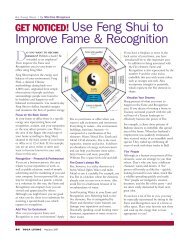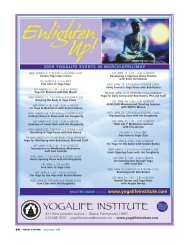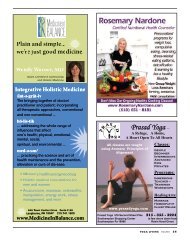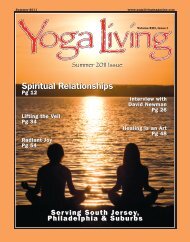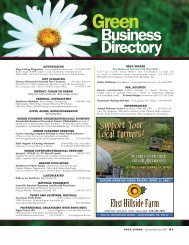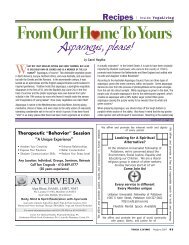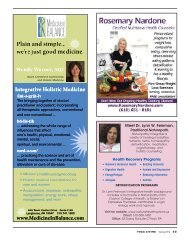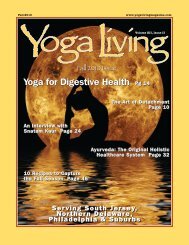Lizard Lunge Practice - Yoga Living Magazine
Lizard Lunge Practice - Yoga Living Magazine
Lizard Lunge Practice - Yoga Living Magazine
You also want an ePaper? Increase the reach of your titles
YUMPU automatically turns print PDFs into web optimized ePapers that Google loves.
Psychology and Health | by Mimm Patterson<br />
Lifting the Veil:<br />
A Personal Journey into the Human Form<br />
Warning: Some portions of this article discuss human dissection<br />
THE BODY IS A WONDROUS AND<br />
HOLY THING. Broken, healed, and<br />
wounded in the spirit or in the flesh: we<br />
are miracles. Our capacity to repair and<br />
recover, to move, to jump, to think, to laugh<br />
at a bad joke – even to be still in quiet<br />
contemplation – is extraordinary. The simple<br />
act of wiggling a toe requires a sequence of<br />
events that reach from our tiniest phalanges<br />
to our brain and back again in the time it takes<br />
to bat an eyelash.<br />
I believe that now more than ever.<br />
But as recently as last year, I wanted proof. I<br />
didn’t want my knowledge of anatomy and physiology<br />
limited to plastic skeletons or what I read in textbooks.<br />
In August 2010, when I was introduced to Gil Hedley via<br />
his “Fuzz Speech” (a video available on YouTube) during Yin<br />
<strong>Yoga</strong> Teacher Training in Northern California’s Santa Cruz<br />
Mountains, I knew that it didn’t have to. I’d found a teacher<br />
devoted to giving the study of anatomy heart and soul.<br />
By October I was registered for his Six-Day Cadaver<br />
Intensive in San Francisco. Five months later the moment<br />
arrived. I picked up a scalpel for the first time since seventh<br />
grade biology class and made a tentative incision. I<br />
retracted the skin of our form’s shin with my hemostat and<br />
examined the superficial fascia.<br />
Six days later I held a brain that fellow students had<br />
meticulously dissected with the spinal cord intact. The<br />
bundle of nerves in our lower back we call Cauda Equina<br />
was exposed and the white filament in the middle of it<br />
all – the filum terminale – was teased into view. It was like<br />
looking into the center of the universe. It was the Source.<br />
It was the proof I’d been waiting to see. The proof I needed<br />
to believe in miracles. And for a moment my gloved hands<br />
held it all.<br />
When my team of eight meets the cadaver at the beginning<br />
of the week, a fitted rubber sheet is stretched over the<br />
dissection table. We lift it together and her form is exposed.<br />
She is covered in layers of white gauze. Each layer of the<br />
gauze wraps around her like a long veil. I’m surprised (and<br />
admittedly relieved) that any sense of the spirit that once<br />
inhabited this shell has disappeared. This is a<br />
human body and we treat it with respect and<br />
dignity, but the essence of who she was has<br />
passed. Even so, as the days progress I find<br />
myself becoming increasingly protective.<br />
Every day we remove layers; skin, fat, tissue,<br />
viscera, bone, brain. Each layer is another<br />
beautiful veil and each time a layer is eased<br />
away, a new secret is revealed. Sometimes the<br />
veil is thin and delicate – the webbed fascia<br />
between muscle fibers – and sometimes it is<br />
dense and compact like the kidney or spleen.<br />
Our reactions to these experiences – whether<br />
it’s the cognitive response to seeing the latissimus dorsi<br />
attachment on the humerus or the emotional awe and<br />
wonder of seeing the tiny, mushroom shaped pituitary<br />
gland – is silent and personal. We might try to share during<br />
Morning Circle, but words are inadequate because as the<br />
veils on our form are drawn back, so are our own veils. How<br />
we perceive the world, our beliefs about death, our longing,<br />
our hopes and our pain – it all floats to the surface, is taken<br />
up and the next layer revealed. We may be using scalpels<br />
and hemostats to examine the forms in front of us, but the<br />
questions we ask ourselves probe as deeply the tools in<br />
our hands.<br />
My fellow Somanauts (the term, coined by our teacher Gil,<br />
refers to our exploration of ‘inner’ space) are a mix of<br />
twenty-eight <strong>Yoga</strong> and Pilates teachers, body therapists and<br />
Rolfers. Most of them choose to work clinically. They are<br />
precise and devoted to their agenda.<br />
Preparing for this workshop, I believed my intentions were<br />
clinical and imagined myself staying focused and working<br />
with surgical accuracy to wheedle a small vessel into view<br />
or coax the retinaculum across the wrist to loosen its grip.<br />
But as I worked, my intentions changed. I no longer wanted<br />
to be focused to the point that everything else around me<br />
disappeared. I wanted to see the Big Picture. In order to do<br />
that, I perched on one of those stools we all remember from<br />
tenth grade chemistry class and took a good look at the view.<br />
We were a group of men and women from Canada, Brazil,<br />
Australia and America ranging in ages from twenty to sixty;<br />
continued on page 36<br />
34 YOGA LIVING Summer 2011



